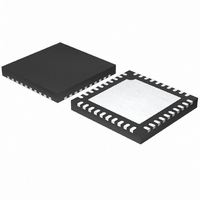MAX8760ETL+T Maxim Integrated Products, MAX8760ETL+T Datasheet - Page 31

MAX8760ETL+T
Manufacturer Part Number
MAX8760ETL+T
Description
IC CNTRLR QUICK PWM 40-TQFN
Manufacturer
Maxim Integrated Products
Datasheet
1.MAX8760ETL.pdf
(39 pages)
Specifications of MAX8760ETL+T
Applications
Controller, 6-bit VID AMD Mobile Turion™
Voltage - Input
4 ~ 28 V
Number Of Outputs
2
Voltage - Output
0.38 ~ 1.55 V
Operating Temperature
0°C ~ 85°C
Mounting Type
Surface Mount
Package / Case
40-TQFN Exposed Pad
Output Voltage
0.375 V to 1.55 V
Output Current
4000 mA
Mounting Style
SMD/SMT
Switching Frequency
550 KHz
Maximum Operating Temperature
+ 100 C
Minimum Operating Temperature
- 40 C
Synchronous Pin
No
Topology
Buck
Lead Free Status / RoHS Status
Lead free / RoHS Compliant
Power-on reset (POR) occurs when V
approximately 2V, resetting the fault latch, activating
boot mode, and preparing the PWM for operation. V
undervoltage lockout (UVLO) circuitry inhibits switch-
ing, and forces the DL gate driver high (to enforce out-
put overvoltage protection). When V
4.25V, the DAC inputs are sampled and the output volt-
age begins to slew to the target voltage.
For automatic startup, the battery voltage should be
present before V
attempts to bring the output into regulation without the
battery voltage present, the fault latch trips. Toggle the
SHDN pin to reset the fault latch.
During startup, the V
gate driver high and the DH gate driver low, inhibiting
switching until an adequate supply voltage is reached.
Once V
at the trigger input initiate a corresponding on-time
pulse (see the On-Time One-Shot (TON) section). If the
V
there is not enough supply voltage to make valid deci-
sions. To protect the output from overvoltage faults, the
controller activates the shutdown sequence.
Firmly establish the input voltage range and maximum
load current before choosing a switching frequency
and inductor operating point (ripple-current ratio). The
primary design trade-off lies in choosing a good switch-
ing frequency and inductor operating point, and the fol-
lowing four factors dictate the rest of the design:
• Input voltage range: The maximum value
• Maximum load current: There are two values to
CC
(V
AC adapter voltage. The minimum value (V
must account for the lowest input voltage after drops
due to connectors, fuses, and battery-selector
switches. If there is a choice at all, lower input volt-
ages result in better efficiency.
consider. The peak load current (I
mines the instantaneous component stresses and fil-
tering requirements, and thus drives output capacitor
selection, inductor saturation rating, and the design
of the current-limit circuit. The continuous load cur-
rent (I
thus drives the selection of input capacitors,
MOSFETs, and other critical heat-contributing com-
ponents. Modern notebook CPUs generally exhibit
IN(MAX)
voltage drops below 4.25V, it is assumed that
CC
LOAD
rises above 4.25V, valid transitions detected
) must accommodate the worst-case high
) determines the thermal stresses and
Dual-Phase, Quick-PWM Controller for AMD
Mobile Turion 64 CPU Core Power Supplies
______________________________________________________________________________________
Multiphase Quick-PWM
CC
Input Undervoltage Lockout
CC
. If the Quick-PWM controller
UVLO circuitry forces the DL
Design Procedure
Power-On Reset
LOAD(MAX)
CC
CC
rises above
rises above
IN(MIN)
) deter-
CC
)
• Switching frequency: This choice determines the
• Inductor operating point: This choice provides
The switching frequency and operating point (% ripple
current or LIR) determine the inductor value as follows:
where η
Find a low-loss inductor having the lowest possible DC
resistance that fits in the allotted dimensions. Ferrite
cores are often the best choice, although powdered
iron is inexpensive and can work well at 200kHz. The
core must be large enough not to saturate at the peak
inductor current (I
I
For multiphase systems, each phase supports a
fraction of the load, depending on the current bal-
ancing. When properly balanced, the load current is
evenly distributed among each phase:
where η
basic trade-off between size and efficiency. The
optimal frequency is largely a function of maximum
input voltage due to MOSFET switching losses that
are proportional to frequency and V
mum frequency is also a moving target, due to rapid
improvements in MOSFET technology that are mak-
ing higher frequencies more practical.
trade-offs between size vs. efficiency and transient
response vs. output noise. Low inductor values pro-
vide better transient response and smaller physical
size, but also result in lower efficiency and higher out-
put noise due to increased ripple current. The mini-
mum practical inductor value is one that causes the
circuit to operate at the edge of critical conduction
(where the inductor current just touches zero with
every cycle at maximum load). Inductor values lower
than this grant no further size-reduction benefit. The
optimum operating point is usually found between
20% and 50% ripple current.
LOAD
L
TOTAL
=
= I
TOTAL
η
I
LOAD(MAX)
PEAK
TOTAL
I
is the total number of phases.
LOAD PHASE
is the total number of active phases.
PEAK
=
⎛
⎜
⎝
(
f
⎛
⎜
⎝
SW LOAD MAX
I
LOAD MAX
):
x 80%.
η
V
I
IN
TOTAL
)
(
−
=
V
(
Inductor Selection
OUT
η
I
)
LOAD
TOTAL
⎞
⎟
⎠
⎛
⎜
⎝
)
LIR
1
+
⎞
⎟
⎠
LIR
⎛
⎜
⎝
2
IN
V
V
OUT
⎞
⎟
⎠
2
IN
. The opti-
⎞
⎟
⎠
31










